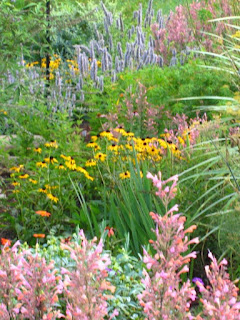
What does it take for a fast-growing flower garden? Good soil, sufficient rainfall and the right plants for the right spot.
When I work with, rather than against, Mother Nature, the garden grows pretty well. In other words, I don't grow anything exotic in my garden!
My garden is in full sun with lots and lots of deer. In 2007, we had a prolonged drought here in zone 7 of North Carolina. That happened to be the same year that I planted 99% of my outer gardens. My "outer" gardens are really just outside the cottage garden fence. I just haven't come up with anything clever to name the whole garden.
There are named sections within the outer gardens... butterfly, rain, fragrance, waterfall, guest parking and driveway island. Not very glamorous, I know. There's a bit of chaos, as I've just plunked some plants in spots within the garden because I don't have a holding bed.
For those who are just getting started with gardening, take heart!
As you can see, the first photo, taken in July 2008, is quite different from the second photo which shows the same garden in May 2007. To understand the vantage point, I have drawn an arrow on the photo to show the same crape myrtle tree. This is a view from east to west, with our driveway and parking areas at the far end of the photos.

Not everything planted in May 2007 survived the drought. I lost coreopsis, deutzia, penstemon and asters and probably a few more perennials that I've since forgotten.
The plants didn't have a chance to get established since it was difficult to keep the garden watered during the drought as there is no irrigation on the slope. There is drip irrigation along the bottom for the rain garden plants. Even though we have our own private well, we didn't feel inclined to risk watering the large area after months and months of prolonged drought.
In spring 2008, I filled in those gaps with salvia, agastache, perennial ageratum, echinops, spirea, monarda, perennial heliotrope, herbs and buddleia.
This area was bare ground on a slope. We first tried sowing grass, but with every rain, the seeds washed down to the bottom of the slope. This is full sun, on the south side, front of the house.
To turn this into a garden, we brought in several double dump truck loads of really great gardening soil. I spent September of 2006 spreading the soil by hand, with a depth of 6-8 inches, over the entire area. It was quite a workout! I planted a few Japanese and Siberian iris that fall along the bottom of the slope to begin creating a rain garden.
As you can see in comparing the two photos, the driveway and parking area are no longer visible. I used buddleia, illicium, amsonia, ginger, and itea beside the large crape myrtle to help define the far end of this garden section.
All of the plants selected are full sun, zone 7, deer resistant plants. No deer repellants have ever been used, but I may resort to rabbit repellants! For just a few months, I did surround the garden with a 32" high wire edging fence to just keep the deer from trampling and sampling the newly planted perennials.
The reason that I think this garden has been so successful is that I started with good soil and selected plants that are drought-tolerant for the top of the slope. At the bottom of the slope, I use plants that like the occasional wet soil. The plants in the middle of the slope like average moisture and rich soil.
There's still a lot of tweaking to be done as I improve the design by increasing the number of hardy plants and removing the ones that aren't good performers.
Photos and story by Freda Cameron



















































